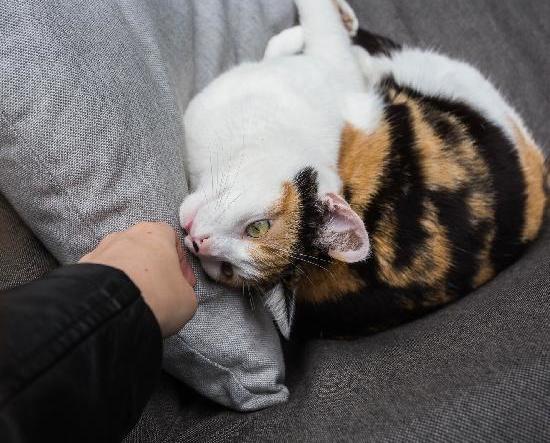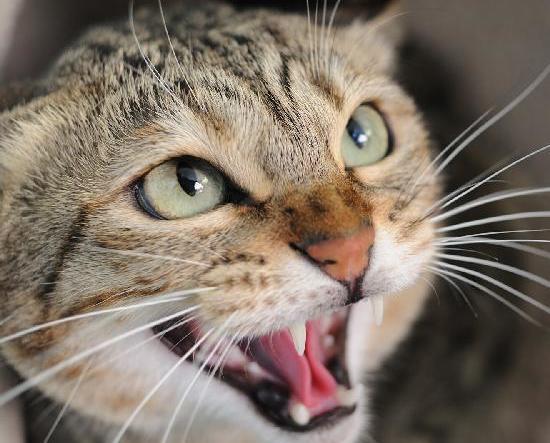
9 minute read
CHOOSING CHOICE
f e l i n e Choosing Choice
Andrea Carne examines a new study that reveals the benefits of allowing cats choice in interaction
Advertisement
© Can Stock Photo / Eillen1981 For cats who share their home with other cats, choice of resources is important so competition is reduced and antagonistic behaviors such as resource guarding are less able to be carried out effectively
Choice. Such a small word. Only six letters. And yet I can think of no other word that has more power when it comes to modifying and managing cat behavior.
I speak to clients (and anyone else who’ll listen) A LOT about this little word and how it can have so many positive effects on a cat’s wellbeing, including their physical health and their bond with their humans. Cats that have choice are happy cats and happy cats are healthy cats. It’s a phrase I use often and I back it up with anecdotal evidence from the many cats I have helped over my time as a behavior consultant.
But it’s always gratifying to hear of some new scientific evidence that supports your belief in a particular aspect of this work, as it helps convince owners that there is real relevance to what you are saying.
Imagine how thrilled I was, then, to read a new study by Haywood et al. (2021), which adds some scientific weight to my love of this word, ‘choice.’ Carried out by a team of researchers at Nottingham Trent University in the UK, the study found that giving cats choice about being petted not only resulted in less aggression but actually made cats more affectionate. It also concluded that being in tune with a cat’s behavior and body language, and taking care as to where a cat likes to be stroked, improved the relationship between human and feline.
The team worked with 100 feline residents of Battersea Dogs and Cats Home in London and a group of human volunteers to test the efficacy of a simple set of guidelines for petting cats. Using the acronym ‘CAT,’ the guidelines encourage people to provide Choice and Control for the cat, pay Attention to their behavior and body language, and consider where best to Touch the cat when they get to that point. To break that down a little:
Providing Choice and Control: Allowing cats the choice to be petted (or not) provides them with a sense of comfort and control which in turn leads to happiness. This can be achieved by gently offering a hand to the cat and allowing it to decide to interact or not. If the cat moves into the hand and rubs against it, great! But if they move away, then that should be accepted.
Paying Attention to Body Language and Behavioral Reactions:
If, during the interaction, the cat displays behavior or body language change (such as turning their head away, rotating or flattening their ears, shaking their head, licking their nose, rippling their fur, swishing their tail), these are all signs they are no longer enjoying the interaction and it should cease. Other signs include if the cat becomes suddenly still, stops purring or rubbing, suddenly starts grooming, or sharply turns their head towards you.
Touching Only the Areas the Cat Is Okay with: Each cat will have
individual preferences and these should be respected. Base of the ears, around the cheeks, and under the chin are generally preferred areas, whereas the tummy and base of tails should usually be avoided.
Behavior
Human participants in the study each interacted with six cats at the shelter – three prior to receiving the ‘CAT’ guidelines and three afterwards.
What the researchers found was that cats petted using the ‘CAT’ guidelines were much less likely to show signs of discomfort or aggressive behavior. All of the negative body language and behaviors listed above were measurably decreased when the human participants followed the guidelines. In fact, the cats in the study were more likely to show friendly behaviors towards the human participants after the ‘CAT’ training. The cats rubbed against the humans, waved their tails and generally seemed more comfortable and relaxed with the interactions.
State Haywood et al. (2021) “… not only did cats behave less aggressively during the intervention condition, but they also performed fewer behaviors associated with conflict or negative affect, as well as more humandirected affiliative behaviors and those associated with positive affect.”
None of this is a surprise to me, of course, but it is always good to have some science behind what I am constantly talking to clients about
Carried out by a team of researchers at Nottingham Trent University in the UK, the study by Haywood et al. (2021) found that giving cats choice about being petted not only resulted in less aggression but actually made cats more affectionate.
and recommending as part of behavior modification and management plans.
Having said all that, in my opinion, choice in interaction is only the beginning of the story. Choice is so very important on a number of levels:
Choice in Resources: By providing a large variety of resources throughout the home, cats have more choice in where they carry out their essential routines of eating, drinking, toileting and sleeping. If they share their home with other cats, choice of resources becomes even more important so competition is reduced and antagonistic behaviors such as resource guarding are unable to be carried out effectively.
There should be plenty of litter trays in a variety of locations throughout the home. Different cats will prefer different locations and the more choice you give, the less likely you will have toileting issues. Offering different types of litter (paper, clay, crystals) and litter trays (size, shape, depth) may also be good options.
It’s also important to ensure food is provided in different forms and via different dispensers in different locations – let the cats choose if they want to eat from a bowl, from a puzzle feeder or via a treasure hunt throughout the house. See what appeals and cater to those preferences (which will change from time to time). Also ensure water is not only offered in different locations but in different ways. Let them choose what they prefer.
Ensure numerous resting and hiding places are offered as cats will often move from one to another throughout the day and will change preferences depending on the season or other factors. It is particularly important that some are at ground level and some are up high with easy access. Provide different types of bedding from a blanket to an igloo to the humble cardboard box.
If the cats have an outdoor cat enclosure, provide easy access to and from the space whenever they please, rather than placing them in it

© Can Stock Photo / bedo If, during any interaction, the cat displays changes in behavior or body language, these are signs they are no longer enjoying the interaction and it should cease Every cat will have individual preferences as to where they are and are not to be petted, and these should be respected

© Can Stock Photo / Annebel146
© Can Stock Photo / AZALIA Play sessions should be kept short and the cat able to disengage and leave at any time

and leaving them there all day with no choice. If the weather changes or they just want the comforts of indoors, they should have the choice to move inside. Ditto for when the house is too noisy or filled with strangers and they need to escape outside!
And don’t forget opportunities to scratch – various scratching posts and mats, both vertical and horizontal and using different textures are essential.
Choice in Training: If training your cat to do certain behaviors or tricks, always start by inviting them to participate using a tasty treat. If they take the treat, you can start the session. Forcing them will get you nowhere.
Keep training sessions short and fun – and allow the cat to leave at any time.
Choice in Play: As with training sessions, keep play sessions short and allow the cat to disengage and leave at any time. Give the cats a variety of toys to play with – both with and without you – and if they seem disinterested in one, try another. Change toys around frequently to add variety. Highenergy play sessions should be kept short – forced, lengthy sessions can end in overstimulation which can lead to scratches and bites.
Use play to allow cats to explore natural behaviors like hunting, but also allow them to say they’ve had enough and walk away. Think about the age, health status and general personality of each cat and adapt play sessions to suit. Not all cats want to participate in highenergy play and that should (and needs to be) accepted by the owner or caretaker.
Now, I realize we can’t offer choice in every situation. We still need to make choices for our cats in terms of health care and we still need to make the overall choices of where they live, whether they have indoor/outdoor access and who they share the home with.
But where we CAN offer choice, we absolutely should.
And, so, I applaud the new study from the team at Nottingham Trent University and I celebrate their use of a simple acronym like CAT to help get the message through. I’ve even been inspired to develop my own acronym for my cat behavior clients: CHOICE Creating Harmony and Optional Interactions in Cats’ Environments.
I may even get some Tshirts designed. Perhaps instead of the “Choose LIFE” Tshirts popular in the 80s, I could instead design “Choose CHOICE” versions for the many cat owners I work with. Such is my dedication to this word and all that it encompasses for the wellbeing of our feline friends. n
Reference
Haywood, C., Ripari, L., Puzzo, J., Foreman-Worsley, R., & Finka, L.R. (2021). Providing Humans With Practical, Best Practice Handling Guidelines During Human-Cat Interactions Increases Cats’ Affiliative Behaviour and Reduces Aggression and Signs of Conflict. Frontiers in Veterinary Science
Andrea Carne is a graduate of the University of Southern Queensland, Australia where she majored in journalism and drama before, later in life, following her dream to work in the field of animal behavior. She is a qualified veterinary nurse and dog trainer and member of PPG Australia. Her special area of interest is cat behavior and her passion for it led to the establishment of her own cat behavior consultancy Cattitude, based in southern Tasmania, through which she offers private in-home consultations.












